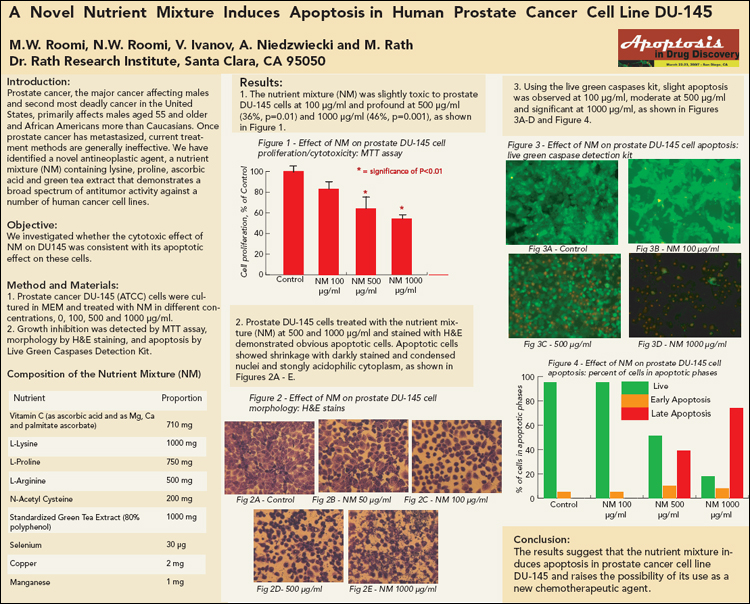M.W. Roomi, N.W. Roomi, V. Ivanov, A. Niedzwiecki and M. Rath
Dr. Rath Research Institute, 1260 Memorex Drive, Santa Clara, CA 95050
Presented at:
Apoptosis in Drug Discovery; San Diego, CA; March 22-23, 2007
Published in:
Proccedings of the GTCbio Conference on Apoptosis in Drug Discovery
Abstract
Introduction:
Prostate cancer, the major cancer affecting males and second most deadly cancer in the United States, primarily affects males aged 55 and older and African Americans more than Caucasians. Once prostate cancer has metastasized, current treatment methods are generally ineffective. We have identified a novel antineoplastic agent, a nutrient mixture (NM) containing lysine, proline, ascorbic acid and green tea extract that demonstrates a broad spectrum of antitumor activity against a number of human cancer cell lines.
Objective:
We investigated whether the cytotoxic effect of NM on DU145 was consistent with its apoptotic effect on these cells.
Method and Materials:
Prostate cancer DU-145 (ATCC) cells were cultured in MEM and treated with NM in different concentrations, 0, 100, 500 and 1000 µg/ml concentration. Growth inhibition was detected by MTT assay, morphology by H&E staining, and apoptosis by Live Green Caspases Detection Kit.
Results:
NM was slightly toxic to DU145 cells at 100-µg/ml and profound at 500 and 1000 µg/ml. DU-145 cells treated with NM at 500 and 1000 µg/ml concentration and stained by H&E demonstrated obvious apoptotic cells. Apoptotic cells showed shrinkage with darkly stained and condensed nuclei and strongly acidophilic cytoplasm. Using caspases kit, slight apoptosis was observed at 100 µg, moderate at 500 and significant at 1000 µg/ml concentrations.
Conclusions:
The results suggest that NM induces apoptosis in prostate cancer cell line DU-145 and raises the possibility of its use as a new chemotherapeutic a gent.
Comment
A novel antineoplastic agent, a nutrient mixture (NM) containing lysine, proline, ascorbic acid and green tea extract demonstrates a broad spectrum of antitumor activity against a number of human cancer cell lines. We investigated whether the cytotoxic effect of NM on DU145 was consistent with its apoptotic effect on these cells. DU-145 cells treated with NM at 500 and 1000 µg/ml demonstrated profound toxicity and obvious apoptotic cells morphologically. Using caspases kit, slight apoptosis was observed at 100 µg, moderate at 500 and significant at 1000 µg/ml concentrations. The results are significant as they suggest NM as a therapeutic agent for prostate cancer, the major cancer affecting males and second most deadly cancer in the United States.
